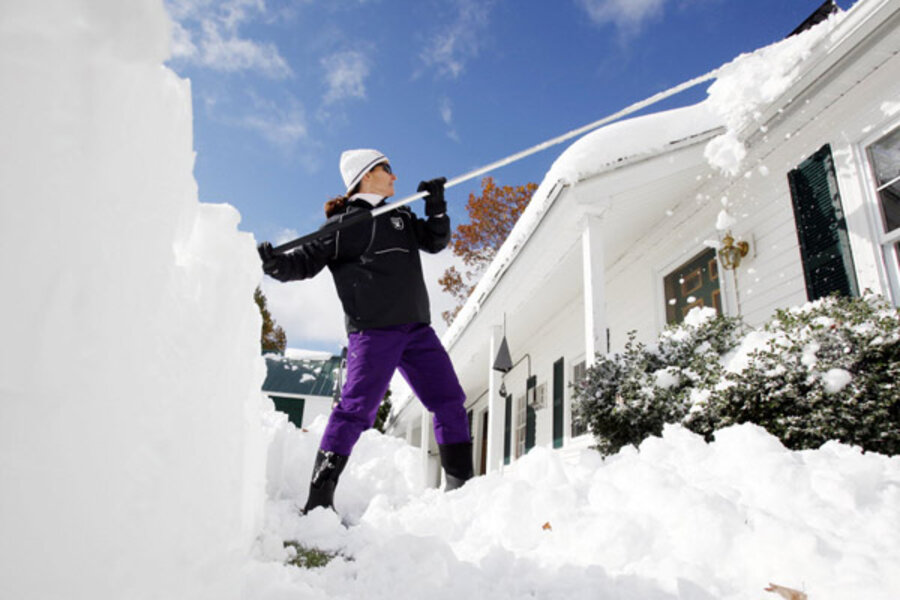Halloween Nor'easter: How unusual was it?
Loading...
| Boston
Weather lore in the Northeastern US is replete with memorable storms – the "Great Hurricane" of 1938, the Blizzard of '78, the April Fool's Day Blizzard of 1997.
To that list you can now add one of the most unusual storms on record – an event that, for now, we'll call the Halloween Nor'easter of '11, which hit Oct. 29 and 30.
"We haven't seen a storm that produced this much snow over such a large area in October," says Louis Uccellini, director of the National Centers for Atmospheric Prediction in Camp Springs, Md., and co-author of a two-volume history of snowstorms in the Northeast.
Comparable storms have appeared as early as late November and as late as early March. And the broad conditions nurturing the storm were typical of the Eastern seaboard's winter nor'easters, so named because the counterclockwise winds circulating around the center of the system come onshore out of the northeast as the storms travel up the coast.
But this late-October storm delivered 10 inches or more of snow from portions of West Virginia into Maine.
In its timing and intensity, "we're in uncharted territory with this storm," Dr. Uccellini says.
The weekend storm struck on the 20th anniversary – almost to the day – of "the Perfect Storm," a destructive Halloween-time nor'easter that blended a powerful mid-latitude storm system with the remnants of hurricane Grace.
This time around, the storm brought heavy, wet snow instead of heavy rains, powerful winds, and a destructive, long-lasting storm surge.
The Oct. 29-30 storm triggered blackouts comparable to those caused by Hurricane Irene's run up the East Coast at the end of August, in which 4 million customers lost power.
In its timing, the storm took a page from the April Fool's Day storm in '97: dumping its limb-snapping load of snow at a time of year when major snow storms aren't usually on the immediate agendas of public-works crews, and, incidentally, setting snowfall records for the date in the process.
Last weekend's event didn't just set records; it shattered them.
In one sense, anything above snow flurries would have shattered records in many places. In New York, Central Park's previous record, a trace of snow in 2002, vanished under 2.9 inches of sticky, white flakes.
Still, the amounts falling in many areas over the weekend were indeed something to write home about. The heaviest snowfall came to interior New England. Peru, Mass., which topped the list at 32 inches. Jaffrey, N.H., tucked into the southwest corner of the state, recorded 31.4 inches. Concord, N.H., saw the storm bring 13.6 inches, compared with a previous record of 0.2 inches set in 1952.
If the 1991 event was a perfect-storm convergence of two storms, this latest record-breaker was a perfect-storm convergence in its own way, Uccellini suggests.
In this case, blame it on the jet stream, a fast moving river of air at high altitudes that steers storms across the continent from west to east. The feature also serves as a boundary between warmer air masses at mid and low latitudes and cold, polar air to the north.
Last Tuesday and Wednesday, a southward dip in the jet stream brought a storm with heavy snow to Denver and other communities along the Rocky Mountains' front range. As that dip worked its way across the continent, it in effect merged with another deep meander in the jet stream that came out of Canada. The two reinforced each other in ways that triggered the formation of a strong low-pressure system at the surface off the US East Coast.
The system's counterclockwise winds swept up moist, relatively warm air from the Atlantic. As the system moved northward along the the meander, or "trough," the moist air clashed with the cold air the trough brought out of Canada. The contrast would set up a rain-snow boundary whose location along the storm's path was initially unclear to forecasters.
Some weather-forecasting models first hinted at the storm's formation as much as six days before it arrived, Uccellini says. Three days later, the full suite of models the National Weather Service considers produced similar projections for the storm's formation.
The only question the model couldn't answer at that time involved the location of the rain-snow line, he explains. Only when the storm was a day or two away could forecasters "really start defining where that rain-snow line was going to be."
The potential for heavy snow in the areas that got it was evident three to four days out. By the time local forecast offices began issuing winter storm warnings on Friday, "it was pretty clear that he heaviest snow would stay inland, from West Virginia all the way up to Maine."
"Given that this was such a rare event, such a historic event, the fact that it was forecast, that people understood the impact with leaves on trees, was quite remarkable," he says.





